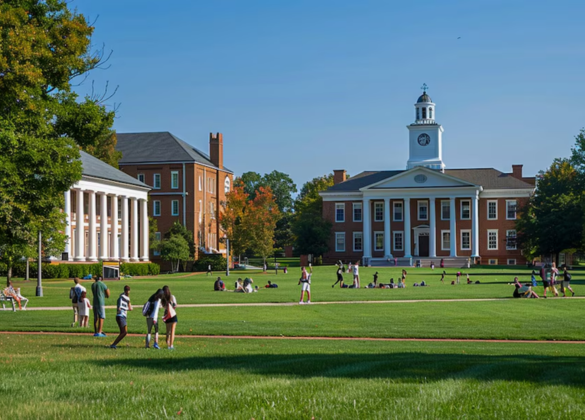Content Marketing for Schools and Universities That Drives Leads and Builds Trust
Today’s era parents don’t just trust glossy brochures anymore, and students don’t fall for slogans and staged smiles. Unlike before, when kids were sent to nearby schools and colleges, modern families research schools like they research a new home.
About 70% of students use search engines as their first step in researching colleges, while 43% of students use social media to follow schools in which they are interested in. (Source: Education Dynamics, 2023).
So, how do they find your academic institution? Content, in the form of stories, videos, blog posts, and student journeys, on different digital platforms like websites, social media, emails, and podcasts.
Welcome to the age of content marketing for schools and universities, where attention is the currency and trust is the sale.
That’s why pairing content marketing with strategic School & University SEO Services is essential to improve visibility, build trust, and drive inquiries from prospective students and families.
At Media Search Group, we specialize in schools & universities content marketing services in Boston (MA), Cambridge (MA), Philadelphia (PA), New York (NY), Miami (FL), Austin (TX), Los Angeles (CA), and all other cities in and outside the U.S. We understand the challenges that education institutes face in attracting the attention of parents with young kids and higher education students.
To bring the best results, we create our entire content strategy for schools, colleges, and universities around:
- Student journey
- School/college milestones
- Seasonal trends
Want to create a growth-oriented schools and universities content marketing strategy?
To get school and university digital marketing tips, with a focus on content marketing, continue reading further.
What is Content Marketing for Schools and Universities?
Higher education content marketing strategies are a strategic approach to creating and sharing content, such as blogs, videos, guides, student spotlights, virtual tours, and more to help families understand what you stand for and why your academic institution could be their learning center.
It’s everything you publish that builds connection and trust without sounding like an ad.
Content marketing is 62% cheaper than traditional advertising and generates 3x more ROI. (Source: Demand Metric)
Traditional Marketing Says:
“Look at our new drama club!”
Content Marketing Asks:
- “Can we show you how we helped Sarah go from a shy high schooler to a Fulbright scholar?”
- “Want to hear how our drama club changed a student’s entire career path?”
See the difference?
One speaks to people. The other speaks with them.
This is what higher education content strategy is all about:
- Inspiring rather than interrupting.
- Educating rather than boasting.
- Guiding rather than pushing.
If your school’s story isn’t online, it doesn’t exist for the next generation. Let’s fix that. Contact our experts to not just promote but make you a top academic brand online for students and high schoolers.
Why Effective Content Marketing for Universities and Schools Matters
About 76% of students use laptops as their primary device (Source: EduCause), while UW Connect says 74.4% of students use mobiles for important education activities. What’s more, 5 out of 10 prospective families chose to do a virtual campus tour, emphasizing the need for online visual content as well.
So, before we dive into the digital marketing strategies for schools and universities, let’s talk about the pain points of schools, colleges, and universities so you know how to make the best out of these insights:
- Enrollment is unpredictable.
- Competition is fierce.
- Digital attention spans are short.
- Families expect more transparency than ever.
A glossy brochure can’t answer tough questions like:
- Is this school inclusive?
- What are the real career outcomes?
- What does day-to-day student life actually feel like?
But content can.
A blog post by a transfer student explaining their experience builds relatability.
A video tour by a current freshman feels real.A guide breaking down financial aid for first-gen families builds trust.
This is how effective content marketing for universities and schools wins:
How to Create a Winning Education Content Marketing Strategy?
When students and families search for the right fit, they don’t want another brochure filled with buzzwords. They want:
- A voice they can trust.
- A school that speaks to them, not at them.
- A message that aligns with their aspirations, beliefs, and educational values.
That’s where your education content marketing strategy starts: not with your logo, but with your mission.
The 4-Step Content Strategy Framework for Educational Institutions
- Step 1: Identify Institutional Goals
- Step 2: Align Content with Audience Segments
- Step 3: Publish Across Strategic Channels
- Step 4: Measure and Optimize by SMART Metrics
Start with Institutional Goals and Build from There
Before you write a single sentence, ask: What are we trying to achieve? The answer “more awareness” or “more applications” is too vague. That’s like saying you want to be “healthier” without a diet or exercise plan.
Your content for schools and universities needs to be tied to strategic institutional goals.
Here’s what that might look like:
- Goal: Increase enrollments in STEM programs.
Content Strategy: Publish blogs on current STEM research at your university. Feature a behind-the-scenes tour of your labs. Launch a video series on alumni working at NASA, Google, and biotech startups. - Goal: Attract more out-of-state applicants.
Content Strategy: Create a microsite dedicated to out-of-state student life, including a “Day in the Life” vlog, budgeting guides, and a relocation checklist. - Goal: Improve community perception of your school district.
Content Strategy: Weekly blog posts featuring student achievements, teacher interviews, and district-wide impact stats. Besides, shareable infographics for social media also do a great job.
Align Messaging with Academic Culture & Values
Parents don’t want to send their child to just any school. Students don’t want to attend a campus that feels unfamiliar or “off-brand.” Alumni don’t want to be part of a story they can’t recognize. They want to be a part of the highest quality educational institution, which is based on strong values and culture. So, your content must reflect your academic institution’s soul.
That means tone, visuals, and topics for education-based organizations must echo:
- Your academic philosophy
- Your commitment to student growth
- Your faculty’s voice
- Your role in the broader educational mission
If you're a liberal arts college with a focus on interdisciplinary learning, your content should lean into stories about creative thinking, diverse career paths, and student-led initiatives.
If you’re a charter school known for STEM and innovation, then your visuals, blogs, and downloadable guides should feel future-facing and bold.
Here’s the rule: Content must look and sound like your campus feels.
Set SMART Goals to Ensure Your Strategy Works
SMART goals keep your content strategy for schools and universities grounded and measurable.
- Specific: Boost organic website traffic to the nursing program page by 25%.
- Measurable: Increase email leads from guide downloads by 200 in Q2.
- Achievable: Launch one new student story video per month.
- Relevant: Grow out-of-state freshman enrollment by 10%.
- Time-bound: Generate 1,000 views on the fall admissions webinar by Oct 15.
Without deadlines, details, and metrics, you’re not doing content marketing but content guessing.
Audience Segmentation: Speak to the Right People
- Prospective students (K-12, undergraduate, grad)
- Parents and guardians
- Current students and faculty
- Alumni and donors
- Guidance counselors, advisors, and influencers
An 18-year-old high school senior browsing Instagram isn’t looking for the same story as a 42-year-old parent reading your admissions FAQ. An international grad student wants different proof points than a local community college transfer. That’s why audience segmentation is your foundation.
Who You’re Really Talking to and Why It Matters
Schools and universities serve multiple overlapping audiences:
Each group has different questions, objections, and decision journeys. Your content should reflect that.

Segment By Stage, Intent, Geography
When creating content for your school or university, start speaking directly to each group like they’re the only one that matters.
Demographics matter, yes. But psychographics and intent are everything in education content marketing. Here’s how to think about it:
- By Stage: Awareness, consideration, decision
- By Intent: Curious browser vs. ready-to-apply applicant
- By Geography: Local commuter vs. international prospect
- By Device Usage: Mobile-first Gen Z vs. desktop-savvy parents
How to Do Audience Research in the Education Sector
Use different SEO tools and tactics to learn more about your audience research and search behavior:
- Google Analytics & GA4: Track where visitors come from, what pages they visit, and how long they stay.
- CRM Platforms: Understand lead behavior across email, downloads, and webinar attendance.
- Surveys & Focus Groups: Ask current students, parents, and faculty about what content helped them most.
- Social Listening Tools: Monitor conversations about your institution and competitors online.
- Search Intent Tools: Use platforms like SEMrush or Ahrefs to see what students search for.
Then feed these insights back into your content strategy. It’s not just about knowing your audience, it’s about obsessing over them.
From Awareness to Enrollment: Guiding the Decision Journey
Great content walks with the target audience every step of the way.
Students don’t apply after reading one blog or watching one video. They move through stages, and your content should move with them.
Awareness Stage
- Blog posts answering broad questions
- Videos on campus life or academic trends
- Infographics and social reels that invite curiosity
Consideration Stage
- Detailed program pages
- Side-by-side comparisons
- Interactive cost calculators or career outcome guides
Decision Stage
- Downloadable application checklists
- Virtual tour access
- Real-time chat, FAQs, and faculty contact forms
Pro Tip: Use content gating wisely. Don’t block essential info, but do collect emails in exchange for high-value downloads like “Your Complete Financial Aid Guide.”
Type of Content Formats for Schools That Educate, Engage, and Convert
Great content isn’t just informative. It’s transformative. Students aren’t just looking for degrees, but they’re also searching for direction.
Blog Content That Reflects Real Stories
In education, the best blog content is human-centered:
- Student stories of resilience, reinvention, and campus life
- Faculty features that highlight research, passion, and innovation
- Program spotlights that answer the “Why this major?” question before it’s even asked
- Student recruitment content that develops trust in your education programs
Post blogs at least 2 to 4 times per month. Aim for 800–1,500 words, SEO-optimized, with strong CTAs.
Infographics (Visual Content)
Use infographics and visual storytelling to make complex systems simple and shareable:
- Explain admissions steps at a glance
- Break down tuition vs. scholarships
- Show career paths tied to majors
- Compare campus housing options
Tip: Design blog for Mobile First. Every graphic should carry your school’s tone, colors, and values.
Video That Brings Campus Life to Screens
- Virtual Tours: Walk them through the campus like they’re already there.
- Day-in-the-Life Vlogs: Let students document their real routines.
- Events and Milestones: Showcase the community, the laughter, the traditions.
Keep it short and authentic. Aim for 60–90 seconds on social, 2–4 minutes for YouTube or website embeds.
Long-Form Content: E-books, Guides, and Digital Resources
- Personalized application guides
- Downloadable budgeting planners
- Relocation guides for international or out-of-state students
- Academic program comparison charts
Tip: Every guide should link to a contact form, tour scheduler, or admissions rep.
Case Studies and Success Stories
- Written case studies with photos and metrics
- Alumni Q&A videos with genuine answers
- Interactive timelines showing student journeys
Repurpose announcements and achievements into persuasive content.
Social Media for Schools and Universities Marketing
Social media is a community builder where your target audience interacts with each other and you.
Choose the Right Platforms by Age & Intent
- K–12 Schools & Gen Z Students: Instagram
- Parents & Alumni: Facebook, Instagram
- Graduate Programs & Faculty: LinkedIn
- Everyone: YouTube for long-form, evergreen video content
Create a Sense of Community
- Share real-time student takeovers during events
- Feature behind-the-scenes posts from staff and teachers
- Use polls, stories, and DMs to engage in dialogue
- Celebrate student wins, birthdays, and club activities
When social content feels personal, it gets shared and remembered.
Promote User-Generated Content (Most Valuable Content)
- #AcceptedStudentSelfie
- “My favorite study spot” video trend
- Alumni flashback stories
User-generated content adds authenticity, increases reach, and shows your community thrives.
SEO and Discoverability for Educational Institutions
If your school doesn’t show up in search, it doesn’t show up in their prospects.
Today’s students and parents start their research online, often with questions like:
- “Best high schools near me”
- “Affordable MBA in New York”
- “Is computer science right for me?”
- Academic programs: nursing, robotics, design thinking
- Geographic intent: in [city/state] or near me searches
- Stage of decision: cost of law school vs. how to apply to law school
- Clear H1 and subheadings with target keywords
- Internal links to related content and next steps
- Image alt text, fast loading times, mobile-first design
- Meta descriptions that invite students and parents to explore your website
Keyword Targeting & Topic Clustering
Think beyond generic terms like "best college." You need a strategic matrix of keywords that reflect:
Organize your blog and resource center around topic clusters, each with a pillar page and related subtopics. This structure boosts rankings and keeps users engaged.
On-Page SEO for School Content
Use structured data (schema markup) to improve visibility in search snippets, especially for courses, events, and reviews.

Local SEO for School Districts and Universities
- Claim and optimize the Google Business Profile of your school/college/university
- Add consistent NAP (name, address, phone) across directories
- Use local keywords in your website copy (e.g., “STEM school in Austin”)
- Encourage reviews and respond to them regularly
Educational Content Campaigns with Microsites and Landing Pages
A homepage can’t do it all. When you're promoting a scholarship drive or a new degree track, don’t just “add a banner” to your main site. It’s better to build dedicated landing pages or microsites for personalized educational campaigns. Why?
- Focus: Strip away distractions. Keep just one call-to-action, one goal.
- Personalization: Tailor the visuals, messaging, and offers to specific audiences (e.g., transfer students or first-gen families).
- Performance: Track every click, scroll, and submission to refine messaging.
These pages become your conversion engine, turning interest into RSVPs, applications, and enrollments.
Use A/B testing tools and heatmaps to optimize headlines, form placements, and CTA buttons.
Virtual Events and Experiences
Brochures are static but experiences are immersive. So, bring your school’s spirit to life online with events that engage, not just inform. Also, create blogs and use social media simultaneously to promote school or university events.
Host Virtual Events That Stick
Use storytelling, real conversations, and behind-the-scenes peeks instead of scripted pitches.
- Live campus tours with student guides answering questions in real time
- Webinars on admissions, scholarships, academic life
- Faculty and alumni panels to humanize your programs
- Q & A sessions with current students for unfiltered insights
SEO Tools That Power Engagement in Schools and Universities' Content
When done right, they become powerful touchpoints that build trust, answer doubts, and accelerate applications.
- Zoom, YouTube Live, or StreamYard for hosting college events
- Hopin or Whova for virtual event hubs
- Interactive chat, polls, and breakout rooms to keep attendees active
- Record everything. Repurpose clips for social, ads, or landing pages.
Content Distribution Channels That Actually Work
To drive awareness, engagement, and applications, you need a multi-channel distribution strategy tailored to the education journey in your school or university.
Owned Channels: Your Institutional Voice
These are your most trusted platforms where you control the narrative:
- School website: Anchor all content here for SEO and authority.
- Blog: Share stories, updates, how-tos, and student life insights.
- Email newsletters: Nurture interest with event invites, tips, and program highlights.
Pro Tip: Segment your email lists by audience (prospects, parents, alumni) for higher engagement.
Earned Channels: Let Others Tell Your Story
Earn credibility for your school or university and reach wider audiences with third-party validation:
- PR coverage in local or national media
- Guest articlesby faculty or student voices in niche publications
- Influencer or alumni mentions on platforms like Instagram, YouTube, or LinkedIn
Earned media builds trust fast, especially with parents and graduate prospects doing deep-dive research.
Paid Channels: Amplify with Precision
Paid media fills in the gaps, helping you target the right audience at the right time:
- Social media ads for open admission duration, deadline reminders and new programs
- Google Search campaigns around high-intent terms like “apply to nursing program in Boston”
- Promoted videos on YouTube or Instagram to showcase campus life or student stories
The key is balance: use paid to drive attention, but always lead them back to rich, owned content that educates and converts.
SEO Analytics and Continuous Content Improvement
The most effective education marketers empower their content marketing strategies with data and insights.
What to Measure (and Why)
- Engagement: Are they reading, watching, clicking?
- Lead conversions: Are they submitting forms or RSVPing for tours?
- Content-assisted enrollments: Which content pieces are influencing decisions of parents and higher education students?
Watch patterns over time and not just one-off spikes.
Tools to Track Smarter
- Google Analytics 4: Understand user paths and engagement
- Hotjar or Crazy Egg: Heatmaps and session recordings for UX insights
- CRM platforms: Tie content performance directly to applicant actions
These tools help answer: What’s working? What’s stalling? Where can you double down?
Content Calendar Strategy for Academic Success
Align your publishing calendar with academic cycles:
- Admission Deadlines: Application guides, virtual tour invites
- Exam Season: Wellness content, study tips
- Orientation: Campus spotlight videos, checklist downloads
- Graduation: Alumni success stories, social takeovers
- Holiday Breaks: Lighter, human-interest content for engagement
Use tools like Airtable, Trello, or Google Sheets to map out monthly themes, audience segments, formats, and owners.
Build Trust and Engagement Through Content Marketing for Educational Institutions
Content Marketing helps schools and universities highlight academic programs, campus life, admissions processes, and student success stories—all while building trust with prospective students and parents. To ensure your content reaches the right audience, start with precise Keyword Research tailored to the education sector. Strengthen your presence in your community with effective Local SEO and enhanced visibility through GBP Optimization. Back it up with Technical SEO to maintain a fast, mobile-friendly, and accessible site. Complement your strategy by building authority through Link Building from reputable education-related sources.
Invest in Education-First Marketing with Media Search Group
Today’s students and families are savvier than ever. They can smell generic marketing a mile away. They want real voices, real answers, and real connections. That’s where Media Search Group comes in.
We don’t just help you “do content.” We help you create high-quality, engaging content for schools and universities, driven by:
- Authentic storytelling rooted in academic culture
- Strategic distribution across high-impact channels
- A commitment to data, iteration, and continuous growth
It’s time to move from content chaos to content clarity.
FAQs on Schools and Universities Content Marketing
Content marketing for schools and universities involves creating and sharing valuable, relevant content, like blogs, videos, and social media posts, to attract, engage, and retain students and parents. It's a long-term strategy that builds trust and showcases your institution’s strengths.
It helps institutions build brand awareness, boost student recruitment, improve search visibility, and connect authentically with prospective students and their families at each stage of the decision-making journey.
Student testimonials, virtual campus tours, program highlight videos, how-to blog posts, and day-in-the-life stories tend to resonate most. Content that is visual, authentic, and mobile-friendly performs best.
Aim for consistency. A good starting point is 1–2 high-quality blog posts per month, weekly social media updates, and quarterly email newsletters. Frequency should match your goals and available resources.
Common mistakes include being too promotional, ignoring SEO, failing to track performance, and not tailoring content for specific audience segments like parents, transfer students, or international applicants.
Ready to elevate your education content marketing?
Let us help your school, college, or university attract more students and parents with school-going kids and boost enrollments.








